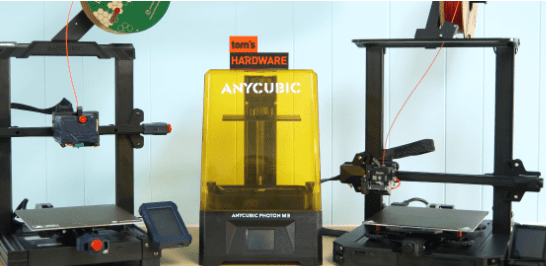3D printers are an interesting way modern technology has been used; FDM printers are some of the most advanced examples you can find. This article promises to give you an overview of FDM printing, followed by a handpicked list of the top ten FDM printers. Let’s go!
What is FDM Printing?
Fused filament fabrication (FFF), commonly referred to as fused deposition modeling (FDM) 3D printing, is an additive manufacturing (AM) technique used in the field of material extrusion. FDM uses thermoplastic polymers in the form of filaments to manufacture parts layer by layer by selectively depositing melted material along a specified route. The process starts by creating 3D models in a 3D modeling software and then its sliced and a G-code for 3D printing is generated.
The most accepted additive manufacturing method is fused deposition modeling (FDM). It has been used in the automotive sector for everything from testing models to producing finished functional parts. FDM is typically the most popular 3D printing technology for prototypes, jigs & fixtures, drill guides, and low-volume production needs because the bulk of their applications requires strong and durable materials.
What is the working principle behind FDM Printing?
Layer by layer, melted filament material is deposited onto a build platform by an FDM 3D printer until you have a finished part. FDM converts digital design files into physical dimensions by uploading them to the machine. Polymers, including ABS, PLA, PETG, and PEI, are among the materials used in FDM. The machine feeds these materials as threads through a heated nozzle. You must first insert a spool of this thermoplastic filament into the printer to use an FDM machine. The filament is fed through an extrusion head and nozzle by the printer once the nozzle reaches the proper temperature. The three-axis system that this extrusion head is connected to enables it to move along the X, Y, and Z axes. The printer deposits melted material layer by layer along a path specified by the design by extruding it into thin strands. The substance solidifies and cools after being deposited. In some situations, you can attach fans to the extrusion head to speed up cooling. Like filling in a shape with a marker, filling an area requires several passes. The build platform falls after the printer completes a layer, and the machine starts working on the following layer. The extrusion head may rise in some machine configurations. Until the portion is finished, this process is repeated.
Which are the 10 best FDM Printer models?
1. Official Creality Ender 3 V2 Upgraded 3D Printer:
The hotbed heats up more quickly, and prints adhere better and without warping, thanks to the carborundum glass platform. Consequently, even the initial layer is ultra-smooth. After an unplanned power failure, customers can resume printing from the latest saved extruder position using the resume printing function, saving time and cutting waste. This model comes with a Meanwell power supply that is UL certified and made by the listed firm using advanced technology to suit all printing and quick heating requirements. Furthermore, the machine is much safer because the power supply is hidden inside. Stronger anti-interference, faster and more steady motion performance, silent printing, and low noise operation are all features of the Ender-3 V2’s integrated self-developed silent motherboard. A rotating knob on the extruder of the Ender-3 V2 makes loading and feeding filament simpler. A brand-new operating system and a 4.3″ smart color screen also significantly enhance user experience.
2. ELEGOO 3D Printer Neptune 2 FDM 3D Printer:
This model uses 3D printing that is smarter. The motherboard and nozzle cooling fans turn off automatically once a print is finished and the nozzle temperature falls below 50 degrees Celsius, saving energy and extending the life of the components. After an unexpected power loss or malfunction, users can pick up where they left off printing. Wide material compatibility and a sensor that detects running out of filament are two features of the MK8 extruder. A short circuit, an overload of voltage, or an Undervoltage can all be better avoided with the 400Watt switched-mode power supply. Under normal indoor temperatures, the 250Watt hotbed can be heated to 100° Celsius in 3 minutes and maintains that temperature so that it may be used to work with various filament materials. Semi-assembled components and CNC-machined aluminum extrusion provide dependable construction and simple assembly. A V-guide roller constructed of German POM material prints for an extended period while moving quietly, accurately, and with high wear resistance. Printing size of 220X220X250mm with 0.1mm high precision. Additionally, the printer supports multi-function add-ons. The printer comes with a one-year guarantee (nozzle and build plate sheet excluded) and lifelong technical assistance with quick customer service response. A better after-sales experience is provided if the consumer needs a replacement item, which the manufacturer will ship to you from the nearby warehouses.
3. Official Creality Ender 3 Pro 3D Printer:
The Ender 3 Pro has a UL-certified power supply that can heat the hotbed to 110°C in under 5 minutes and shield your printer from unanticipated power spikes. After unplanned power disruptions, the Ender 3 Pro can restart printing from the last recorded extruder position. The simple-to-build kit comes partially assembled, allowing you to gain knowledge of the fundamental design of 3D printers as you assemble the printer, giving you a fascinating STEM education experience in electronics and mechanical engineering. Your 3D printer’s build plate is completely protected by the detachable build surface plate, which also maintains a constant temperature on the build surface. The cooling process makes it simple to remove the printed models.
4. ANYCUBIC Vyper 3D Printer:
An intriguing characteristic is the small body but large printing volume of 9.6″(L) x 9.6″(W) x 10.2″(H) / 245 x 245 x 260mm. The ANYCUBIC Vyper 3D printer has an advanced leveling mechanism that properly detects 16 points and adjusts the height of the nozzle from the platform with only one click. This function is user-friendly for both experienced users and beginners. The PEI Spring Steel Magnetic Platform, used in the Vyper 3D printer, is made of spring steel and a unique coating that prevents deformation at high temperatures, provides a scratch-resistant covering and makes it simple to remove models by bending or popping. It works well with PLA, ABS, PETG, and TPU filaments. The system can operate more quickly and smoothly thanks to its high-performance Cortex-M3 main control chip and new 32-bit motherboard. The TMC2209 silent driver enables the motherboard to manage voltage output precisely and print silently, improving printing accuracy.
5. Longer LK5 Pro 3D Printer:
With the support of the TMC2208 ultra-quiet driver, it exhibits strong qualities and lowers noise. Users can test their brilliant ideas on the LK5 Pro with open-source firmware by altering the G-code. Additionally, BL touch installation is offered separately. The 3D printer uses open-source firmware and has a 4.3-inch full-color touch screen with an improved user interface (UI) for simple operation. On the screen, users may see real-time printing information. The interface has larger touch screens than comparable printers, measuring 2.8 inches. The upgraded version of the LK5 Pro FDM 3D Printer features a lattice glass plate, making removing the model simpler and flatters the hotbed for improved printing adhesion. A filament detection sensor system automatically stops printing when the filament runs out to save time and filament. The Recover Printing Function aids in restarting printing after a power outage.
6. ANYCUBIC Kobra 3D Printer:
The ANYCUBIC Kobra 3D Printer can print at a maximum speed of 180 mm/s and an average speed of 80 mm/s, which is 167% faster than the industry standard and allows consumers to wait for less. Users can actualize their incredible creativity thanks to the big construction volume of 8.7×8.7×9.84in / 220x220x250mm, which provides enough space and freedom. An all-in-one frame 3D printer, ANYCUBIC Kobra, can reduce shaking to enhance print quality. The printer can be put together in about 10 minutes, thanks to its modular architecture. To achieve simple, quick, and precise leveling and give users a more intelligent printing experience, this model is built with the self-developed Anycubic LeviQ Leveling Function equipped with 25-point precise leveling up. This function can automatically correct the unevenness of the heated bed.
7. Official Creality Ender 3 PRO 3D Printer:
The Ender-3 PRO is an improved model of the original Ender-3. It features the same exceptional performance as the Ender-3 but with improved parts that make it more reliable, robust, and user-friendly. For Ender-3 PRO, a brand-new, cutting-edge “C-MAG” magnetic sticker has been created. It is entirely releasable, flexible, and has improved platform adhesion. The user should detach the magnetic upper from the lower when the model has finished printing and bend or flex the print surface for the model to pop off the surface readily. The power supply protects the printer from voltage peaks and power disruptions. Prints may be continued from the last layer if there is a power outage, saving time and reducing waste.
8. FLASHFORGE 3D Printer Adventurer 3C:
The Adventurer 3C is completely enclosed in design, with no exposed cables. When the door is closed, the voice printing is incredibly quiet when the door is closed—only 45 dB. The flexible heated construction plate has not warped even after 400 hours of bending testing. Additionally, it can be heated to 60 °C to avoid model warping during printing. Adventure 3D is recognized as one of the best affordable 3D printers for schools, families, and creators due to a wonderful balance between simple operation and amazing 3D prints with smooth surfaces and realistic textures. To firm up the bed, the producers removed the bed springs and added an auto bed leveling sensor, allowing consumers to level the bed for the first time and never worry about it again.
9. Official Creality Ender 3 S1 3D Printer:
The independently created CR Touch Sensor is a feature of the Ender 3 S1 3D printer. The intelligent leveling system can automatically correct the erroneous height (accuracy 0.04mm) at various areas of the printing bed, which effectively raises the quality and success rate of model printing while facilitating easier and more accurate leveling of the bed. Ender 3S1 operates more smoothly and synchronously thanks to its Z-axis dual-screw+Z-axis dual-motor design, which reduces the likelihood of lines and ridges appearing on the sides of your print and enhances printing quality. The Ender-3 S1 can detect filament runout, breakage, or power outage and restart printing after recovery. It helps to prevent the waste of filaments by precisely documenting the printing data at the time of a power outage/filament runout or breaking.
10. Delta FDM 3D Printers:
Finding points in 3D space are done differently with a Delta 3D printer. The print head is mounted on three moving arms as opposed to a print head that travels along the forward-backward, left-right, and up-down axes. To move the print head, these three arms independently push and pull on it. Differentiating between Cartesian and Delta 3D printers involves a certain amount of a ” grey area.” This is so that points can still be plotted following the Cartesian coordinate system by Delta 3D printers. But the coordinates must be converted into the precise angles at which each of the three articulating arms must be placed. Simple trigonometric functions are used to perform this translation.
Apart from the two FDM printer movement kinds we’ve just discussed, there are two others that are significantly less prevalent. The first is a 3D printer called the Polar that has a print bed that spins and moves in relation to a stationary print head. The Selective Compliance Assembly Robotic Arm (SCARA) printer, a very accurate and incredibly small 3D printer that looks like it was taken straight out of a science fiction film, is the rarest type of FDM printer.
Conclusion
In conclusion, FDM 3D printers are technologically more advanced 3D printers when compared to SLA or resin printers and come with several new features such as auto leveling, print resuming, and better power sources. If you are trying to start 3D printing and want to learn 3D designing, consider the interactive tutorials provided by SelfCAD.



































